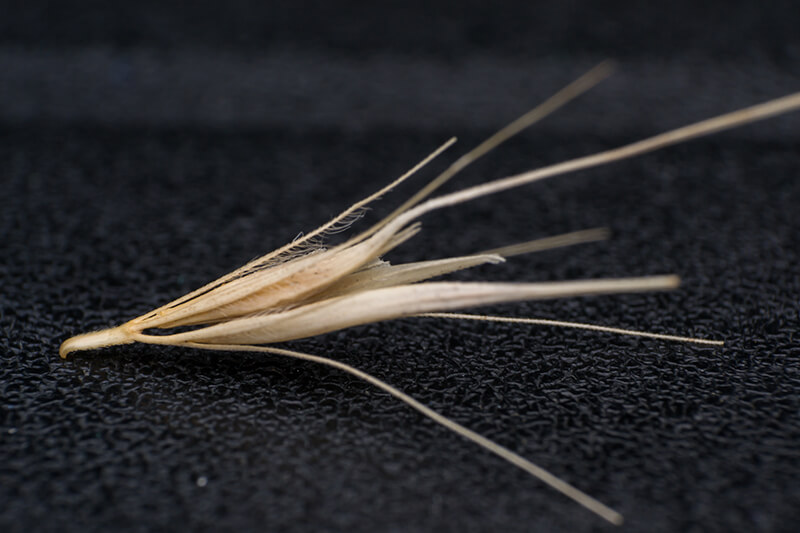If you live in the Western United States, including Southern California, you’ve likely come into contact with a grass-like weed called foxtail. Other names for foxtails are grass awns. Foxtail has tough barbed seed heads and can easily embed in your dog or cat’s nose, skin, eyes, and ears. It’s important to know what to look for if your pet has come into contact with foxtails.

Where Are Foxtails Found?
You can come into contact with foxtails in open areas such as hiking trails, fields, and even in parks. In our area, foxtails are found in many places and cause injuries to pets, especially to dogs, hundreds of times a year. You may find this spiky plant stuck to your socks or shoes after a hike.
How Do Foxtails Harm Pets?
Foxtails are spiky and hard and they are designed to burrow to spread and this same design makes it easy for them to latch onto animal fur and penetrate the skin. The barbs of the foxtail embed the seed in the skin, or into the ears, eyes, nose, and paws.
How Can I Tell if My Pet has a Foxtail Injury?
Paws
Foxtails in your dog’s paw is a common foxtail injury. The most common symptom is swelling on the top of the paw, between the toes. You may notice your dog (or cat) limping, or excessively licking their paws. You may see swelling or even notice an infection. It’s important for you to get to the vet if you notice infection, or if you notice symptoms.
Eyes
If a foxtail is embedded in your pet’s eye you will notice the eye watering or a discharge, swelling closed or squinting. This can lead to blindness so seeking veterinary care right away is important.
Genitals
Foxtails can also work their way into the prepuce of the penis of the vulva. Your dog may begin persistently licking their genitals if they have a foxtail in those sensitive areas.
Nose
Your pet can inhale a foxtail seed. While this is less common than other injuries, if your dog sniffs around a trail or a field, they can easily inhale a foxtail. If this happens, your dog will suddenly begin to sneeze violently and likely will experience a bloody nose. This is serious because the foxtail can enter through the nose and exit out the eye, causing permanent damage.
Ears
The ear is actually the most common body part affected by foxtails. The foxtail will move down the ear canal toward the eardrum. The most common symptom of a foxtail in the ear is a rapid onset of your dog is shaking its head vigorously, tilting its head to one side, or pawing at its ear. There may even be discharge from the ear. In addition, loss of balance may also occur. If you notice these symptoms, visit your vet right away before permanent damage can occur.
Foxtail injuries can migrate from one area of the body to another. One example of this is that a foxtail in a paw, if untreated, can make its way to the lung, leading to a more serious problem.
Foxtails can cause infections. Be sure to check your pet if they are lethargic, are experiencing swelling or bleeding anywhere, and especially if you see or smell an infection. If this occurs, take them to an emergency vet, like EPIC Vets, right away.
Foxtail Injury Treatment
What to Expect Most foxtail injuries can be treated outpatient; however, the key is quick intervention by a veterinarian.
Moderate Sedation – Foxtails in the ears and eyes usually require moderate sedation. These injuries are painful and many pets simply do not like their ears to be handled, much less scoped for foxtails.
Full Sedation – Foxtails in the nose will require full anesthesia because most dogs will still sneeze while under light or moderate sedation, which can complicate the removal of the foxtail.
Foxtails in the paws and toes require full anesthesia and a small surgical procedure to open the area where the foxtail is suspected to be, and many times, the foxtail has migrated up the leg. If this occurs, an ultrasound can be used to locate the foxtail but this is rare. If the foxtail can’t be found, a veterinarian might wait and watch to see if an abscess forms in another part of the body such as the shoulder or neck. In some cases, a CT scan may be recommended to locate the foxtail.

Foxtail Prevention
When you’re hiking, keep an eye out for foxtails and steer your pet away from areas where it’s growing. After a hike, it’s a good idea to brush out your dog’s fur and check them over for foxtails. There are also products you can use to prevent foxtails including face protection and booties for paws. If you are an avid hiker, those products might be a wise investment.
It’s best to avoid foxtails whenever possible. If you do encounter them, be sure to thoroughly inspect your pet’s hair, ears, and between their toes. A foxtail injury is considered medically urgent and your pet should be seen by your regular veterinarian or EPIC if your vet is unavailable. Our staff is available 24/7 to help pets in emergency situations and treat hundreds of foxtail cases each year. Contact us to start the intake process before you arrive.



